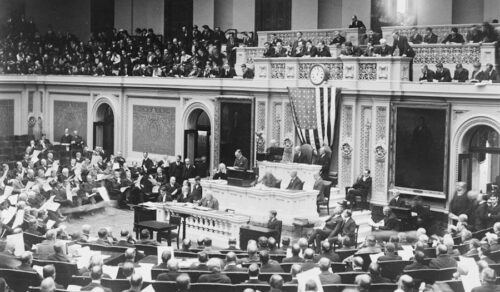
Today’s political climate is noted for its division. Old news, right? Actually, disunity within the Union goes back much farther. While it may have started at the creation of these United States of America, our pursuit of happiness with each other certainly ran into difficulty during events like the Civil War. A million casualties later we smoothed that one over, only to see other divides. One hundred years ago, the U.S. was in the middle of a prolonged clash, this one between town and country. Coming into the 1920s, change was everywhere.
Every ten years, the federal census counts citizens with an eye toward reapportioning our representation. Fairly standard stuff. Since the beginning of the Republic, cities had been growing, but always outnumbered by the rural population. That meant traditional values always held a majority when it came to the passage of laws.

Photo: Congress in the 1920s could get along no better than today.
For Americans on farms and in small towns, big city values were seen as dangerous and a threat to their more wholesome way of life. That’s why Prohibition advocates needed to get the 18th Amendment passed before the 1920 census brought greater representation for the growing urban areas, a place where consumption of alcohol was thought strongest. The drys initially succeeded, most believing that once passed, a constitutional amendment could never be overturned. However, debate over strong beverages continued. Some turned to illegal measures to get a drink. Others, wanted exceptions for beer and light wine. Groups like the Anti-Saloon League would not be moved.
The U.S. Constitution calls for one representative in the House of Representatives for every 130,000 citizens. If we lived by that requirement, the House would today have 2,562 members. Instead of 14 members from North Carolina currently, there would today be 82, an unwieldy number.
It was during this fight between rural and urban in the growing, roaring 1920s that the issue exploded onto the political scene. For most of the decade, the country side kept the city side from greater (and legitimate) representation. To put the matter in perspective, North Carolina gained a new congressional district after the 2020 census, giving the Tarheel state a 14th district, thanks to population growth. Here in 2024, that new member has already been elected and is serving in Congress. Such would have never happened a century ago.
Rural forces kept any kind of redistricting from happening for most of the decade. Obstructionists used one dodge after another to keep change from happening, dragging their feet at every turn so that in the election of 1928, American citizens were represented according to what it looked like in 1910, that is to say, extremely outdated.
It wasn’t until the summer of 1929, before a deal was struck. Just before the 1930 census was poised to change representation again, Congress finally agreed to accept the 1920 data. Along with it, they decided on a cap of 435 members, instead of letting the original document dictate how many would be required. Ten years. It took ten years before a compromise could be reached because some saw temporary political advantage.
Opposition to each other is nothing new. Some say bullheadedness is on the rise but when compared to past events like refusing to accept the political realities of population growth because it diluted strength, our times might not seem as fraught with trouble as those of a hundred years ago.









